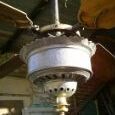I was looking for fans for parts at a local flea market and saw this fan. I paid a bit too much for it. 60 dollars but it was in really good condition and it only took me about 4 hours to tear it down, strip and paint it, and new wiring. Runs smooth and the only part that was a PITA was that ring holding on the cage, and two sides and the motor. You need 5 hands to do it.
